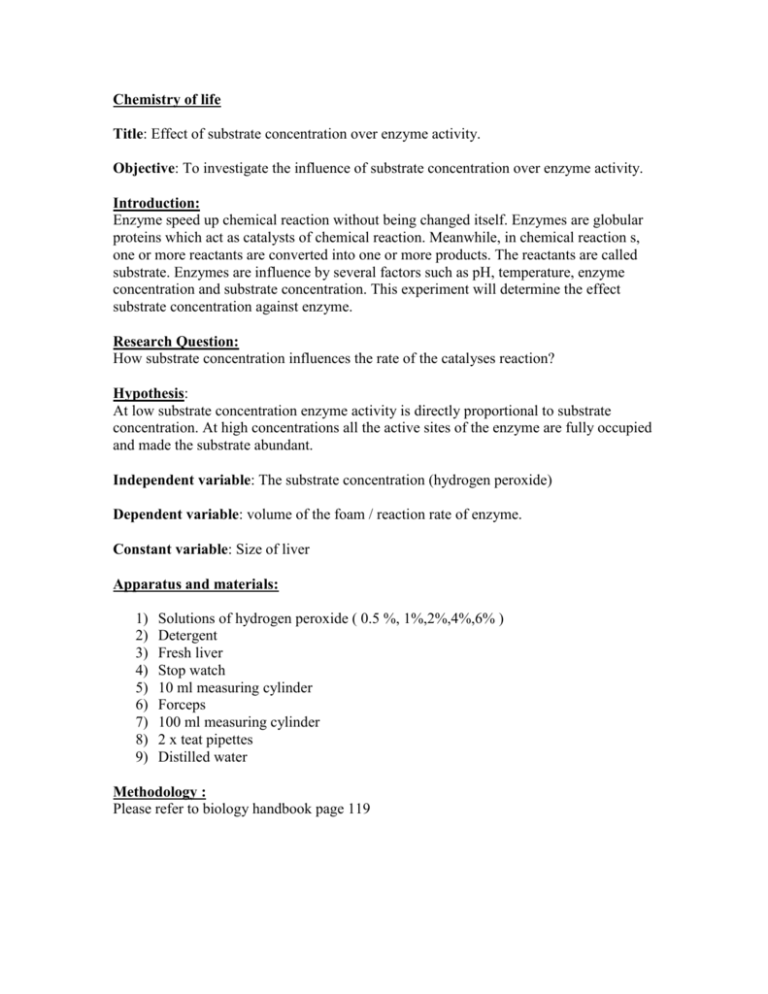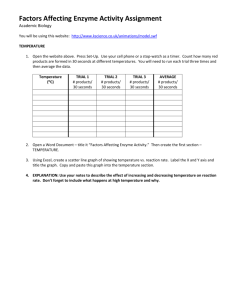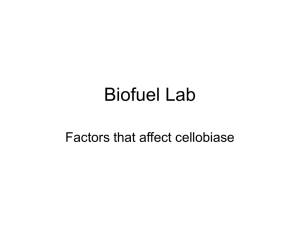Effect of substrate concentration over enzyme activity
advertisement

Chemistry of life Title: Effect of substrate concentration over enzyme activity. Objective: To investigate the influence of substrate concentration over enzyme activity. Introduction: Enzyme speed up chemical reaction without being changed itself. Enzymes are globular proteins which act as catalysts of chemical reaction. Meanwhile, in chemical reaction s, one or more reactants are converted into one or more products. The reactants are called substrate. Enzymes are influence by several factors such as pH, temperature, enzyme concentration and substrate concentration. This experiment will determine the effect substrate concentration against enzyme. Research Question: How substrate concentration influences the rate of the catalyses reaction? Hypothesis: At low substrate concentration enzyme activity is directly proportional to substrate concentration. At high concentrations all the active sites of the enzyme are fully occupied and made the substrate abundant. Independent variable: The substrate concentration (hydrogen peroxide) Dependent variable: volume of the foam / reaction rate of enzyme. Constant variable: Size of liver Apparatus and materials: 1) 2) 3) 4) 5) 6) 7) 8) 9) Solutions of hydrogen peroxide ( 0.5 %, 1%,2%,4%,6% ) Detergent Fresh liver Stop watch 10 ml measuring cylinder Forceps 100 ml measuring cylinder 2 x teat pipettes Distilled water Methodology : Please refer to biology handbook page 119 Result: Quantitative: Hydrogen peroxide / % 0.5 1 2 4 6 Volume of foam / ml 1 2 3 9.00 17.0 20.0 34.0 35.0 10.5 17.0 20.0 34.0 34.0 9.00 16.0 22.0 36.0 35.0 Average volume of foam / ml Reaction rate / ml s-1 9.500 16.67 20.67 34.67 34.67 0.150 0.389 0.522 0.989 0.989 Qualitative: When the cube of liver is put in the cylinder contained detergent and hydrogen peroxide, it formed foam and are finished when the entire enzyme in the liver fully occupied. Reaction rate / mls-1 : average total volume – 5 30 s Data processing Graph of enzyme activity against substrate concentration Rate of reaction, ml s 1 0.989 0 4 6 Concentration of hydrogen peroxide, H 2 O 2 , % Conclusion: At low substrate concentration enzyme activity is directly proportional to substrate concentration. At high concentrations all the active sites of the enzyme are fully occupied and made the substrate abundant This mean that the enzyme is more active when the substrate concentrations is at the high level. But till certain level when the substrate concentrations are high enough the reaction rate become constant as all the active sites are fully occupied. Conclusion and evaluation 1) At low substrate concentration, enzyme activity is proportional to substrate concentration .This is because random collision between substrate and active site happen more frequently with higher substrate concentrations. 2) At high substrate concentrations, all the active sites of the enzyme are fully occupied, so raising the substrate concentration has no effect. 3) According to my opinion , the result gave us the appropriate results that what are we predicted. The graph of the result can be considered similar with the theoretical graph that we have learned before. 4) There could some error in the reading or data collection process in collecting the volume of the foam as the volume of the liver used maybe slightly different from each other due to the complication in obtaining constant volume of the liver. The effect of volume will influence the reaction rate of the enzyme. 5) There are some precautions during the experiment that is all the glass must be rinsed before it is used .Remember to wash your hand after handling the fresh liver to avoid any bacteria infection. 6) The different concentration of the detergent for each group also can be consider as the error in the experiment because when the students are compared their results among themselves, they will get different readings from their experiments. Therefore the concentration detergent must be standardized to each group. Limitations:1) The volumes of the livers are slightly different from each others and this may affect the experiments. 2) The volume of the hydrogen peroxide might be change because it is very reactive and some of the substrate has already broken into water and oxygen .This will somehow influence the experiment results. 3) The different concentration of detergent might be affected the reaction rate and the reading. References book : 1. IB STUDY GUIDES BOOKS (ANDREW ALOTT) 2. STUDENT’S HANDBOOK FOR BIOLOGY INTERNATIONAL BACCALAUREATE







